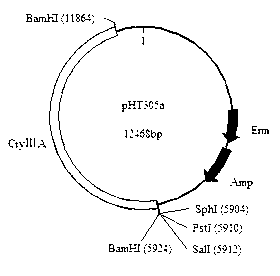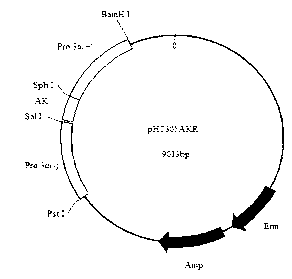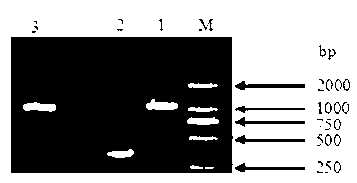Plasmid for expressing plutella xylostella arginine kinase genes dsRNA (double-stranded ribonucleic acid) and application
A moth arginine kinase and plasmid technology, applied in the field of genetic engineering, can solve the problems of affecting Bt, short residual period, narrow insecticidal spectrum, etc., and achieve the effect of improving insecticidal effect and reducing cost
- Summary
- Abstract
- Description
- Claims
- Application Information
AI Technical Summary
Problems solved by technology
Method used
Image
Examples
Embodiment 1
[0029] Embodiment 1, construction of plasmid pHT305AKR
[0030] 1. Bacillus thuringiensis cryⅢA Preparation of the promoter fragment of the gene
[0031] 1.1 Extraction of plasmid pHT305a
[0032] Take a single colony containing the plasmid pHT305a strain and culture it overnight in LB liquid medium (containing 50ng / ml Amp and 50ng / ml Erm), and use the high-purity plasmid miniprep kit (product catalog: DP1002) to extract the plasmid pHT305a.
[0033] 1.2 PCR amplification of Bacillus thuringiensis cryⅢA pro3α(+) promoter fragment of the gene
[0034] Using the plasmid pHT305a as a template, a pair of primers were designed (the 5' ends of the two primers were introduced into Bam H I and Sph I digestion recognition sequence and protection base).
[0035] Upstream primer 01F: 5'-GTCT GGATCC GAAATTAGTTATACAAGCATT-3' (underlined as Bam H I recognition sequence);
[0036] Downstream primer 01R: 5'- ACAT GCATGC TTTTCTTCCTCCCTTTCTT-3' (underlined as Sph I reco...
Embodiment 2
[0090] Embodiment 2, construction and application of Bacillus thuringiensis engineering bacteria
[0091] 1. Plasmid extraction
[0092] Take a single colony containing the plasmid pHT305AKR and culture it overnight in LB liquid medium (containing 50ng / ml Amp and 50ng / ml Erm), and extract the plasmid pHT305AKR with a high-purity plasmid miniprep kit (product catalog: DP1002).
[0093] 2. Competent preparation of Bacillus thuringiensis BMB171
[0094] 2.1 Cultivate BMB171 overnight at 30°C on a shaker at 200r / min.
[0095] 2.2 Transfer to LB medium according to 1% inoculum amount, and cultivate to OD at 30°C and 220r / min 600 1.2-1.5 so far.
[0096] 2.3 Place the culture medium in step 2.2 on ice for 10 minutes, transfer to a large ice pre-cooled centrifuge tube, and centrifuge at 6000 r / min, 4°C for 10 minutes.
[0097] 2.4 Discard the supernatant, add 10ml of ice-cold SG buffer, centrifuge at 6000r / min, 4°C for 10min, and remove the supernatant. Repeat 3 times.
[0098] 2...
PUM
 Login to View More
Login to View More Abstract
Description
Claims
Application Information
 Login to View More
Login to View More - R&D
- Intellectual Property
- Life Sciences
- Materials
- Tech Scout
- Unparalleled Data Quality
- Higher Quality Content
- 60% Fewer Hallucinations
Browse by: Latest US Patents, China's latest patents, Technical Efficacy Thesaurus, Application Domain, Technology Topic, Popular Technical Reports.
© 2025 PatSnap. All rights reserved.Legal|Privacy policy|Modern Slavery Act Transparency Statement|Sitemap|About US| Contact US: help@patsnap.com



